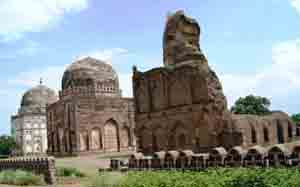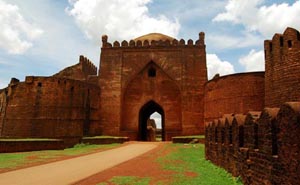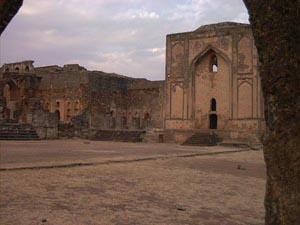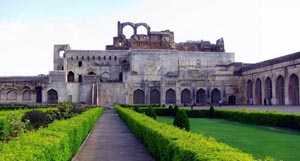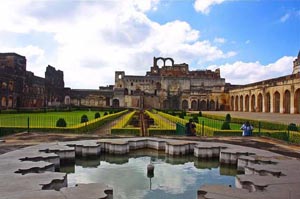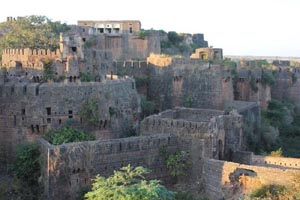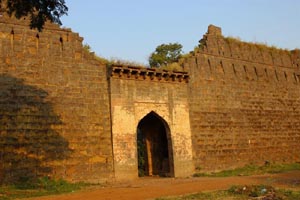Bidar Monuments - Historical Places to Visit in Bidar
Historical Monuments / Forts / Palaces / Places to Visit in Bidar
Here you can check list of names and information on famous historical forts / palaces / monuments / places to visit in Bidar, Karnataka, India. These famous monuments of Bidar are most visited and most sought after best tourist places. You can also find images of Bidar monuments / places / forts / palaces.
Bahamani Tomb is outmoded on the basis of historical mark of Bahamani Sultan's death in the year 1436, therefore making it the most primitive tomb in the cemetery. The tomb's portico is composed of three storeys curved pointed fortes. It is a planned architecture with semi-circular roof and has remarkably stunning decoration. There are three entrances of Bahamani Tomb, situated in north, south and east fronts respectively.
The Fort is constructed on the periphery of the plateau. It has a disorganized quadrangular layout figure, which is 0.75 miles in length and 0.5 miles in breath. The peripheral length of the walls measured is 4,500 yards. The ramparts, bastions, gates and barbicans of Bidar are however, well conserved and well thought-out as, some of the most fashionable in India. The Fort is bordered by a triple moat.
The Mahal was constructed in between the period of 1426-1432 by the rulers of the Bahmani i.e. Ahmed Shah Bahmani. The Mahal lies in the west side of the Bidar fort. It was extensively used by the rulers during the period to address private audience of the kingdom. The structure of the building is deemed to be made following a complex design. The Mahal has a durbar hall were various ceremonies and important functions of the Kings of Bidar had taken place.
The architecture of the monument is an important point that should be emphasized to get a better and close understating about the outlook of the fort. There lies a decorative emblem in the upper section of the fort that portrays the prominence of the Bidar rulers. The interior of the upper storey was designed in such a manner that the roof directly connects with the 'Solah Khamb Mosque'. The middle storey of the monument is decorated elegantly with tiles and stone.
Built in the year 1524, the monument was originally constructed by King Mahmud Shah Bahmani. Historical facts suggests that some part of the fort especially its part was built by Ali Barid Shah who was a Bidar ruler. The monument is believed to be one of the best preserved in the history of the state. The monument is also popular as the title of queen palace as women from various nationalities resided in it.
Basavakalyan Fort was tactically created by considering defence mechanism in an imperceptible environment. The fort was not noticeable unless the enemies are at nearby distance. This locational benefit help to resist any enemy assaults. Basavakalyan Fort was created by intersecting huge rocks which are spread throughout the hills, along with robust walls. It has guard rooms and towers. There are three concentric asymmetrical walls in the fort.
Bhalki Fort is a famous heritage structure with an open air congregational field. The fort was created on about 18000 square kilometre, i.e. approximately within five acres of land. It encloses a small jungle outside the Bhalki town. Bhalki Fort is about seven meter height and is created by using locally accessible black stones as well as home-made lime grout mix. There are open walls inside the fort and at the outside of the fort, there is a small pond. However, at present, the pond has been dried up.
- Bangalore Monuments
- Bagalkot Monuments
- Belgaum Monuments
- Bellary Monuments
- Bidar Monuments
- Bijapur Monuments
- Chitradurga Monuments
- Coorg Monuments
- Dakshina Kannada Monuments
- Gadag Monuments
- Gulbarga Monuments
- Hassan Monuments
- Mysore Monuments
- Raichur Monuments
- Uttara Kannada Monuments
- Yadgir Monuments
- Andaman Nicobar Monuments
- Andhra Pradesh Monuments
- Assam Monuments
- Bihar Monuments
- Chhattisgarh Monuments
- New Delhi Monuments
- Goa Monuments
- Gujarat Monuments
- Haryana Monuments
- Himachal Pradesh Monuments
- Jammu and Kashmir Monuments
- Karnataka Monuments
- Kerala Monuments
- Madhya Pradesh Monuments
- Maharashtra Monuments
- Odisha Monuments
- Punjab Monuments
- Rajasthan Monuments
- Tamil Nadu Monuments
- Telangana Monuments
- Uttar Pradesh Monuments
- West Bengal Monuments
